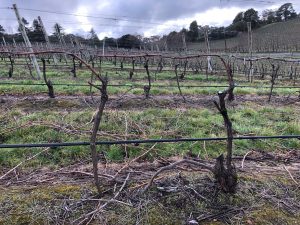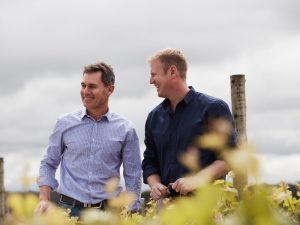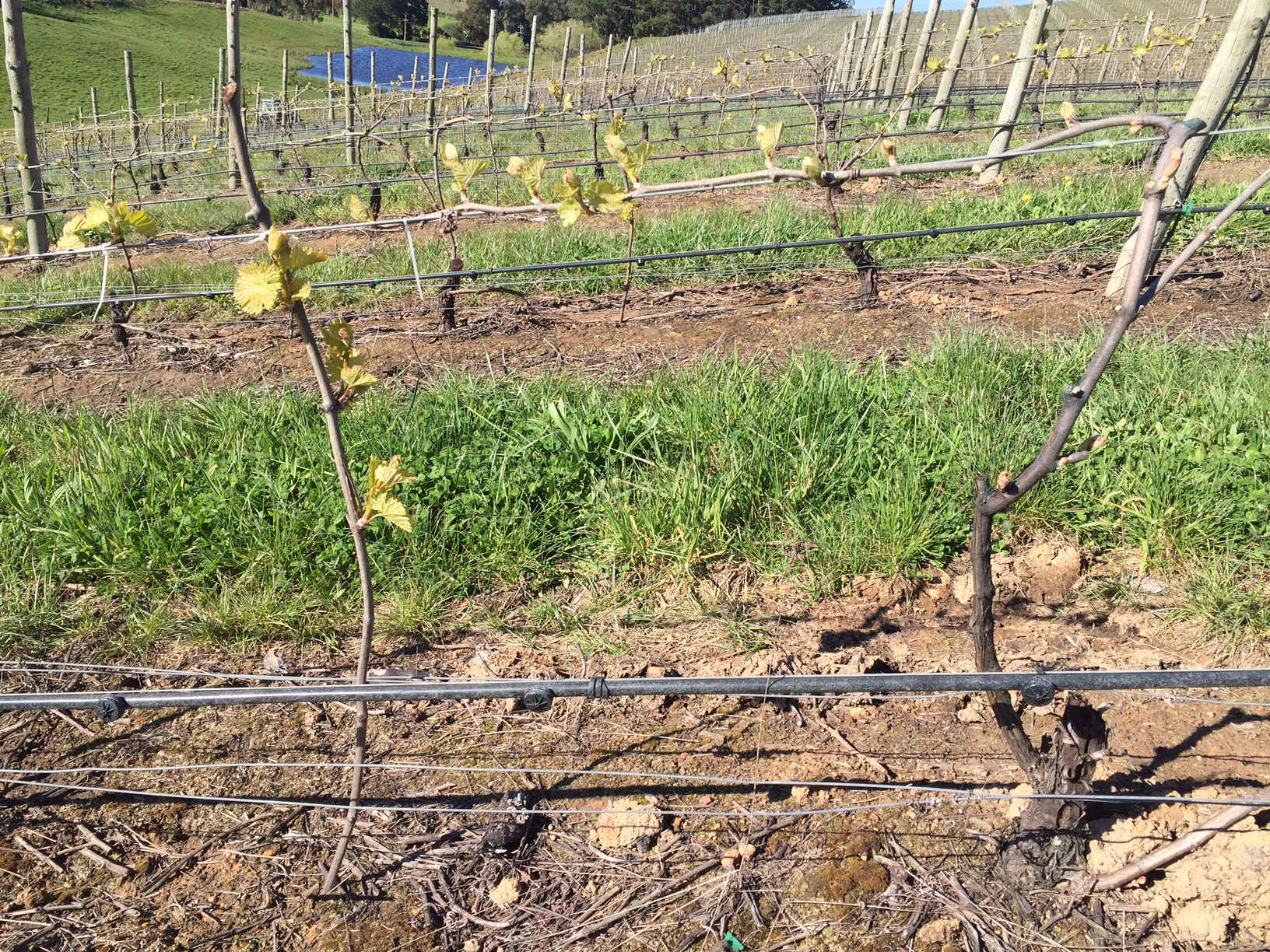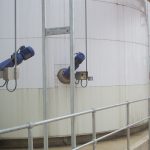A vineyard practice most commonly used to replace missing or damaged vines is being utilised by one innovative Adelaide Hills viticulturist with a completely different purpose in mind. Hans Mick reports.
Shaw & Smith’s Lenswood vineyard, situated at a cool 455-500 metre elevation in South Australia’s Mt Lofty Ranges, is home to established rows of Chardonnay, Pinot Noir and Sauvignon Blanc.
The 20 hectare operation was first planted in 1999, but over the last three years a new and ongoing project has been undertaken to increase the site’s vine density.
Group viticulturist Murray Leake is behind the plan which aims over time to introduce vine layering to the entire vineyard. He said so far the unconventional practice had proven highly successful.
“All the vines have worked and grown well, trunks are thickening up and they’re producing fruit.
“And it’s allowed us to carry pretty much half the crop load per vine and achieve the same yield. It just means that each vine doesn’t have to work as hard.
“You’ve pretty much got two trunks and two root systems supporting what before had one trunk and one root system supporting the volume of fruit.”
He said the technique was ultimately beneficial to improving the quality of the grapes produced.
Leake said layering had worked well on the site where established, well-performing vines were to be retained. This is in contrast to the company’s other Adelaide Hills vineyard at Balhannah, where vines have been removed to change variety and planted at a higher density.
“In any new blocks that we’re planting […] we’ll completely remove vines […] we’re actually increasing our vine density, so we’re putting the vines closer together in the row.
“We removed some Pinot from Balhannah and we’ve planted Shiraz which have been planted closer at a higher density with new planting material.
“But in the situation [at Lenswood] we want to keep the Chardonnay and keep the Pinot in those blocks because it works well, but we think it would work even better at a closer density.
Leake explained that Lenswood’s established vine row spaces were 2.8 metres, with vines spaced at 1.5 metres apart.
“It’s not really practical to go and plant another vine in between each vine to increase the density because you have that competition from the mature vine against a young vine.
To overcome this, the enterprising viticulturist tapped into the layering method that’s traditionally been used to simply replace vines that are either missing, damaged or knocked out of the ground by machinery.
While Leake stopped short of claiming to be an ‘absolute pioneer’ in using this method to increase vine density, he said he hadn’t heard of anyone else doing it before, especially on a large scale.
“It’s not really a new method, it’s a really old method,” he said. “Actually, it’s been done for a long time in a lot of different regions.
“But I don’t know of any other people that have done it to double their vine density.”
”I reckon 99% of vineyard managers would have seen layering and would have maybe even done it themselves to replace a missing vine.
“But I expect that it’s pretty uncommon to do it over an entire vineyard,” he said.
A ‘simple process’
As one of the Adelaide Hills region’s most respected viticulturists —having worked in a number of other South Australian regions as well—Leake is familiar with most practices aimed at improving vine performance and grape quality. He described his creative use of vine layering as a “pretty simple process” that others could easily follow.
“[In conventional layering, you] take a shoot from an existing vine in winter and you bury that in the ground. So you dig a hole, put the shoot in the ground, but then have the end of the shoot sticking out of the ground.
“So we’ve done it in a whole different way,” he explained.
“Rather than replacing the odd missing vine here and there, every mature vine we have cut off to approximately 30cm above the ground and then we’ve allowed them to reshoot.”
He said the process meant an entire crop had to be skipped.
“Then during the next growing season, spring and summer, we have them grow new shoots which they just push from the trunk down close to the ground, along that trunk.
“We run one shoot back up to our existing cordon wire and then we run the other one along the irrigation drip wire to about the position where we want to layer it, so it’s running in line with the existing vines, not into the mid row.
“Then we have a string where we run it up to the cordon wire so it runs across in an L-shape and grows up through the wires and we get that growth through the growing season.”
Leake said in the following winter during dormancy, layering then took place.
“We dig a hole and we insert that dormant cane that we’ve grown along the drip tube into the ground. We have part of that cane coming out of the ground and that’s secured up by the cordon wire.
“So we then have two new trunks: one that’s joined on to the old trunk and coming straight up and one that’s joined on to the old trunk but running along the row and into the ground and then back up to the cordon wire.”
He said the material that’s been buried in the ground would then develop a root system of its own, but importantly, one that’s also supported by the existing vine, which Leake and his colleagues call the ‘mother vine’.
“So rather than plant another vine in between that has to look after itself, the vine that’s been planted in between is a layer that’s got support from the mother vine, which helps it to grow a root system.”
He said this then also supported itself once that root system developed.
“Because we’ve got our irrigation sorted out to provide water and nutrition to each one of those layers, it really makes it easy.
“You’ve got the support of the mother vine which provides nutrients to that shoot and support to the new shoots that grow from the buds while it’s developing a root system.”

A year on from the layered vines in Shaw & Smith’s Lenswood vineyard depicted on the feature image, the diameter of the trunk on the layered vine and the ‘mother vine’ are now very similar, while the selection of the layer where it enters the ground from the ‘mother vine’ has not increased at the same rate. Vineyard manager Murray Leake believes this is an indication that the layered vine is fully functioning from its own new root system.
Avoiding layering failure
Leake said while layering could be adopted in most regional climates and conditions, there were a few simple rules to follow to ensure it’s done effectively.
He said if planting was too shallow, then there was the potential for failure.
“One of the keys is that when you layer you don’t just stick it in the ground, you actually have to make sure you bury it deep enough, make sure it’s secure in the ground and there’s a bit of work to make sure it’s done correctly,” he said.
“I’ve seen people layer it and it hasn’t worked very well, the vines haven’t been very strong because they don’t go in deep enough when they do the initial layering.
“If it’s a dryer region and they don’t have drippers that can support it with irrigation, it can dry out quite quickly and it just doesn’t develop a strong root system.”
He said, ideally, irrigation systems should be set up to distribute water and nutrients equally to both the new and mature vines.
Leake said the training of the layers was the only other important consideration.
“Obviously you need to do some work during the growing season to make sure you’re training it properly and looking after them just like you would with any vine that you’re growing.”

Shaw & Smith group viticulturist Murray Leake and winemaker Adam Wadewitz.
Project expansion
Shaw & Smith’s layering project has worked so well, its continued expansion at Lenswood, and potentially beyond, is now ensured.
“This is our third year of layering so the first block that we did was about three hectares. We layered every single vine and had another vine layered in between.
“That has grown and we had the first full crop last year. We’re still only cropping Chardonnay at seven tonnes a hectare and the wine is fine.”
He said the layers were still attached to the mother vines.
“For how long we leave them attached we’re not sure yet. But generally what you’ll find is the trunk from the vine that you’ve layered, you’ll see that will start to outgrow, or the diameter of that will be much more than the original bit of material that you’ve taken from the mother vine.
“So where it’s come from the vine running down, that tends to stop enlarging; and the trunk that’s coming out of the ground starts to enlarge which is a fairly good sign that the root system is functioning really well.”
The layering project currently covers six of the Lenswood vineyard’s total
20 hectares.
“Eventually it’s probably going to cover the whole vineyard,” said Leake.
“We’ve got about another two and a half hectares that have been cut off for layering this year. So we’re slowly progressing it across the vineyard.”
And the practice may also be expanded to Shaw & Smith’s Tasmanian operation, Tollpuddle Vineyard, in the Coal
River Valley.
“We’re already pretty close in Tasmania. The majority of the blocks there are 2.2 metres wide, by 1.2 metre vine spacings. The new plantings we’re doing down there are rows of 2.2 metres and the vines are 0.75 metres, so it’s pretty high density,” Leake said.
But with a portion of the vineyard having vines with 1.5 metre spacings, he said the layering technique was being explored.
“We haven’t started it yet, but it’s something that we’ll probably look at,” Leake concluded.
















